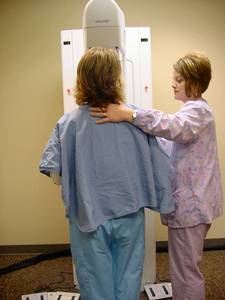

 Mammograms are important tools in the early discovery of breast cancer. Early detection of breast cancer greatly improves chances for survival, as well as often meaning less invasive and debilitating treatment. Iowa Specialty Hospitals offers both 2D and 3D mammography.
Mammograms are important tools in the early discovery of breast cancer. Early detection of breast cancer greatly improves chances for survival, as well as often meaning less invasive and debilitating treatment. Iowa Specialty Hospitals offers both 2D and 3D mammography.
With digital mammography, the radiologist reviews electronic images of the breast, using special high-resolution monitors. The physician can adjust the brightness, change contrast, and zoom in for close ups of specific areas of interest. Being able to manipulate images is one of the main benefits of digital technology.
Three-dimensional (3D) mammography, also known as digital breast tomosynthesis, is the latest mammogram technology being used for breast cancer screening. A 3D scan takes a series of x-rays of the breast from different angles and then creates a 3-dimensional image of the breast. The breast is positioned and compressed in the same way as a conventional mammogram.
The 3D scan allows doctors to examine your breast tissue layer by layer. So instead of viewing all the complexities of breast tissue in a flat image, fine details are more visible and no longer hidden by the tissue above or below.
All women benefit from a mammogram screening. However, women with dense breast tissue are likely to benefit the most. Dense breast tissue means a woman has more glandular tissue compared to fatty tissue. On a mammogram, glandular tissue appears white, while fatty tissue appears gray. However, cancer is also white on a mammogram. Since the radiologist is able to view the breast as thin slices, a 3D mammogram can better differentiate a cancer from overlying glandular tissue, increasing cancer detection and decreasing chances of a false positive.
3D mammography has been shown to have higher cancer detection rates. While it is not a silver bullet (some breast cancers are not detected with 3D mammograms), it is a definite improvement over 2D mammography. 3D mammography also has a lower recall rate, meaning that fewer women need to return for additional images or testing.
For most women, 3D mammography is the best choice. However cost is a consideration. As the equipment is more expensive, and the exams require more time to interpret than 2D, there is an increased cost to providing 3D. While Medicare is paying the additional fee, some private insurers are not. The additional fee may apply to your deductible. You should check with your insurance provider for the potential of increased costs before undergoing a 3D mammogram.
From the patient’s point of view, mammography with a digital system is essentially the same as the screen-film system. The mammograms will be taken the same way. Each breast is placed between two plates and an x-ray is taken. This takes only a few seconds and will be performed by a trained technologist. Most women say the compression is uncomfortable but not painful.
There is really no preparation needed for a digital mammogram, but there are some things to remember before you go. Dress comfortably: a two-piece outfit is usually the most convenient because you will need to undress above the waist. You should not use any type of powders, deodorants, ointments or creams prior to your exam because they can affect the quality of the mammogram. If possible, you should not schedule your mammogram just before or during your menstrual period, especially if you have breast pain at that time. The complete exam takes about 30 minutes.
Women age 40 and older should have an annual mammogram, regardless of whether it’s 2D or 3D. Mammography is the only test that has been shown in multiple studies to lower a woman’s risk of dying from breast cancer. Annual mammograms beginning at age 40 saves the most lives. Always check with your healthcare provider for the best plan to meet your individual health needs.
To learn more, please visit our Locations and Hours page for contact information.